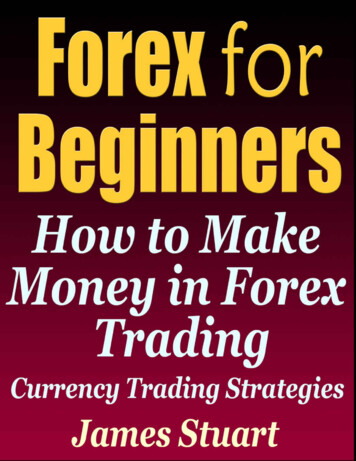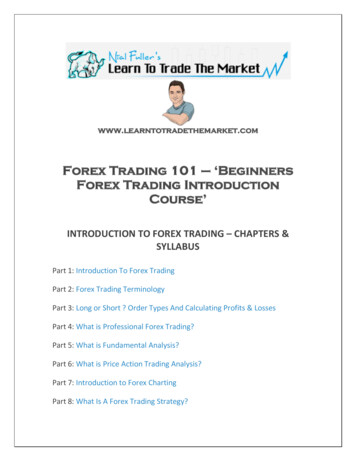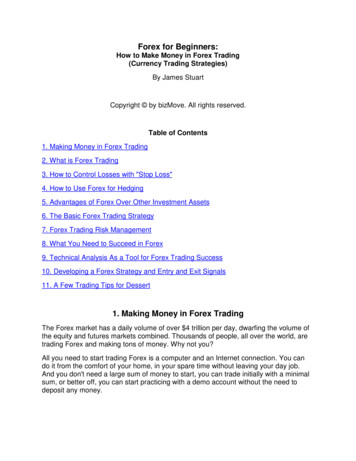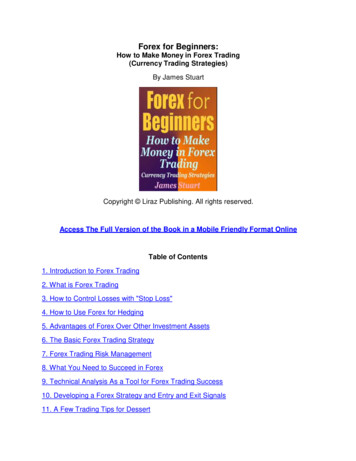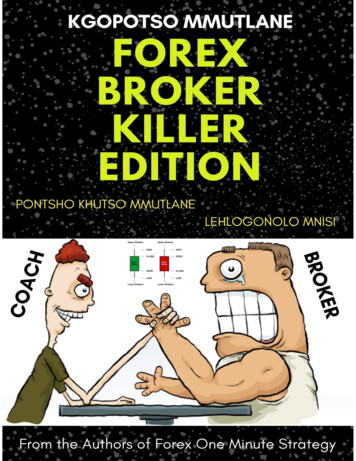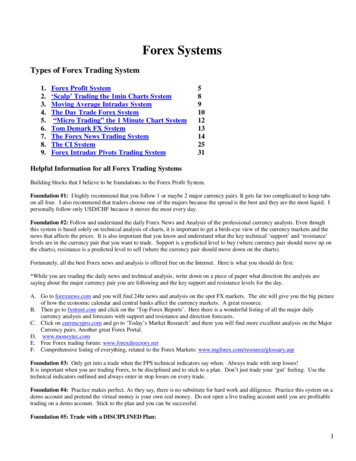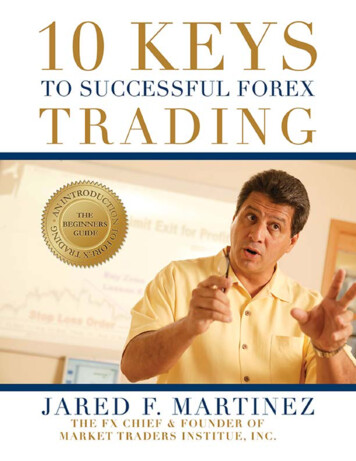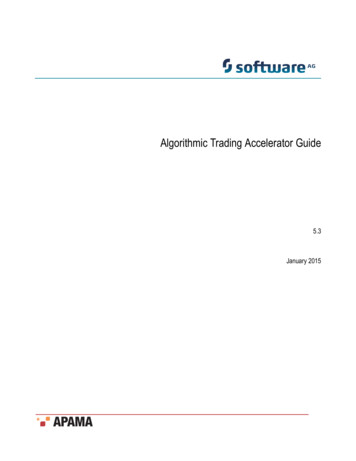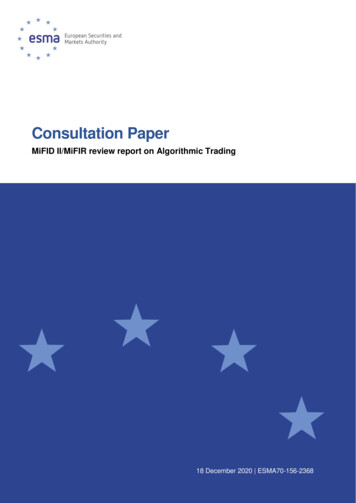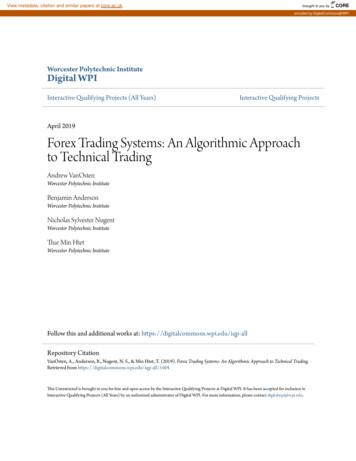
Transcription
View metadata, citation and similar papers at core.ac.ukbrought to you byCOREprovided by DigitalCommons@WPIWorcester Polytechnic InstituteDigital WPIInteractive Qualifying Projects (All Years)Interactive Qualifying ProjectsApril 2019Forex Trading Systems: An Algorithmic Approachto Technical TradingAndrew VanOstenWorcester Polytechnic InstituteBenjamin AndersonWorcester Polytechnic InstituteNicholas Sylvester NugentWorcester Polytechnic InstituteThar Min HtetWorcester Polytechnic InstituteFollow this and additional works at: https://digitalcommons.wpi.edu/iqp-allRepository CitationVanOsten, A., Anderson, B., Nugent, N. S., & Min Htet, T. (2019). Forex Trading Systems: An Algorithmic Approach to Technical Trading.Retrieved from https://digitalcommons.wpi.edu/iqp-all/5404This Unrestricted is brought to you for free and open access by the Interactive Qualifying Projects at Digital WPI. It has been accepted for inclusion inInteractive Qualifying Projects (All Years) by an authorized administrator of Digital WPI. For more information, please contact digitalwpi@wpi.edu.
Forex Trading Systems:An Algorithmic Approach to Technical TradingAn Interactive Qualifying ProjectSubmitted to the Faculty ofWORCESTER POLYTECHNIC INSTITUTEIn partial fulfillment of the requirements for theDegree of Bachelor of ScienceByBenjamin Anderson (REL 1804)Thar Min Htet (REL 1802)Nicholas Nugent (REL 1810)Andrew VanOsten (REL 1808)Date: April 24, 2019Submitted to:Professors Reinhold Ludwig and Gbetonmasse Somasse of Worcester Polytechnic InstituteThis report represents work of WPI undergraduate students submitted to the faculty as evidenceof a degree requirement. WPI routinely publishes these reports on its web site without editorialor peer review. For more information about the projects program at WPI, seehttp://www.wpi.edu/Academics/Projects
AbstractIn financial trading, emotion can often obstruct clear decision making. The goal of thisproject is to build a system which can overcome this by trading foreign currencies autonomously.Three systems were created: two relying on neural networks, and a third on pattern recognitionof candlestick charts. A fourth system has been designed to allocate funds to the others usingutility theory. Though the algorithms were not profitable, a powerful interface was built,connecting Python scripts to MetaTrader 4 for trading.1
AcknowledgementsWe would like to thank Professors Reinhold Ludwig, Gbetonmasse Somasse, and HosseinHakim for their insight and guidance throughout this project.We would also like to thank Worcester Polytechnic Institute for allowing us the opportunity ofworking on the project.2
Executive SummaryIntroductionMany people spend decades of their lives working in order to make and save money. Itcan be quite easy to equate money with comfort or power. Consequently, it is not hard to becaught up in the idea of maximizing one’s assets. Compensation for employment can be quiterigid, and often lower than one may desire, leaving employees searching for other sources ofincome. One way that this could be accomplished is through long-term investment in equitiesand federal bonds. When carefully thought out, this approach can provide a relativelyconservative extra income over a long period of time. For those who desire a greater reward,albeit at an increased level of risk, there exists an alternative: short-term trading of equities,currencies, commodities, or other assets.Decades ago, short-term trading was not accessible to the average person. However, theadvent of the internet, and the associated “Information Age” has brought brokerage platformsinto the hands of the general public. With a potentially small initial investment, this type oftrading can be an attractive means of generating funds. Without careful planning and analysis, itis very easy to lose money in any active market. To consistently make a profit over time, wehypothesize that one must have a very disciplined and scientific system of trading methods.While no system can work perfectly in any situation, a common source of error is theperson doing the trading. Humans are easily swayed by emotion and, as a result, tend to not bevery good at following the recommendations of a system. People frequently believe they aresmarter than the system, and feel that they can make better decisions, in the pursuit of a greaterprofit. Some algorithmic trading systems aim to solve this by executing a set trading strategy,while others aim to make a profit by running at extreme speed with the goal of exploiting tinyinconsistencies in a market [1]. This project focuses on the development of carefully plannedalgorithmic trading systems, which aim to incur a profit by carrying out predefined actions basedon technical analysis. When driven by careful analysis, we see this algorithmic approach as anoptimal solution for making money in a stock or currency market.GoalsThe goal of this Interactive Qualifying Project is to eliminate the psychological andemotional aspects of manual trading by creating an autonomous trading system which is capableof making short-term trades of foreign currencies. The system will be driven by a combinationof scientific and thoughtful technical analysis, and by neural networks. We do not believe that it3
is possible that a single, realistic algorithm, which would trade successfully in any situation, canexist. The goal of this project is therefore to create a set of algorithms that can each functionunder certain conditions. Together, these systems create a more holistic solution to the problemthan any individual algorithm could.Results and ConclusionsIn order to accomplish the goals set forth above, three systems were implemented. Twoof these systems planned to experiment with using neural networks. Because of this, we decidedto write our trading systems in Python as it has a large set of neural network and machinelearning libraries including TensorFlow, Scikit, and Numpy. We also decided that we wanted touse MetaTrader for testing these systems because of its robust trading and backtestingframework. In order to use Python and MetaTrader together, we created a pair of programs, onein MetaTrader’s MQL4 language and one in Python, which pass messages to facilitate trading.MQL4 passes tick data to Python which, if it chooses, can return a command to place a buy orsell order.The following sections summarize each of the three trading systems, as well as the assetallocation system.An Approach with Recurrent Neural Networks using Long Short-Term MemoryDeveloped by Thar Min HtetThis trading system is implemented using Recurrent Neural Networks (RNNs) with LongShort-Term Memory (LSTM). This design was chosen over other types of neural networksbecause of its ability of RNNs to handle time series data, such as financial data, very well. LSTMis an add-on to improve the performance of RNNs. This model is not designed to tradecurrencies live; it is designed to be incorporated into other trading strategies and give support todifferent systems. With further development, such as implementation of the connection toMetaTrader, this system could be used for live trading of currencies.The workflow for the system is summarized as follows.1. Remove noise from raw currency data using a wavelet transform3. Train the network on a subset of the processed dataset4. Tune Hyperparameters5. Test the accuracy with both training and testing data6. Make a prediction of the currency price at the next timestepAutomated Momentum Indication via Candlestick Patterns4
Developed by Andrew VanOstenLooking for patterns in candlestick charts is a common practice among traders. Just likeany other indicator, these patterns cannot always give a perfectly clear signal to the trader.However, they can still provide a valuable indication of trend reversals. These patterns are verysimple to search for with an algorithm as they are defined by the open, high, low, and closeprices for each bar—data that are easily available. By using somewhat agreed-upon definitionsof common patterns, an algorithm can quickly search an incoming stream of data for potentialsignals.These signals each represent the potential for a change in the direction of a trend.However, most traders would not base a trade on this signal alone; similarly, this algorithm takesa slightly deeper approach. A market which is in a downtrend is likely to see several bullishsignals as it nears its low point, before reversing and moving upwards. This algorithm generatesa small positive signal for each bullish signal, and a slightly negative signal for each bearishsignal. Different patterns can be given individual weights to allow for differing reliability ofeach pattern. These small signal values are simply added to an overall momentum “score” whichis used as a signal to buy or sell. As time moves forward this score will decrease exponentially,as the signals seen previously will be less accurate as they grow further into the past. The finalvalue of the score at the n th time-step is defined as:M (tn ) D · M (tn 1 ) εwhere M (t) is the momentum score being generated, tn is the current time-step, tn 1 is theprevious time-step, D is the decay constant where 0 D 1 , and ε is the signal beinggenerated—a constant proportional to the reliability of the pattern that has been observed. Thisfunction was created in order to model the desired behavior of the system. When M (t) 1 , onelot of the selected currency is bought, and when M (t) 1 , a lot is sold. When M (t) 0.5 , anycurrently held orders are closed, as this represents a loss of confidence in the indicator. Only oneposition of one lot may be held at any time.Unfortunately, this system was not able to produce a profit over time. However, there arecountless combinations of currency pairs, timeframes, and system tunings that could potentiallyproduce better results. At the very least, this system could act as a basis or source of ideas forfuture research.Q-Learning using Neural NetworksDevelopment by Ben AndersonThis system attempted to use Q-learning along with neural networks to assign values topotential states which the market could have. The first attempt used pure Q-learning. A5
feed-forward neural network was fed information about the past 20 bars in the market, as well asthe current trade, if any, which was in place. Before being fed into the system, data waspreprocessed—reformatted in order to represent each bar relative to the previous bar, or to theopen price of the current bar. Representing the data in this way allowed the system to considereach state independently without having to account for differences in the range of input data.Once all data was fed in, the network was trained using the following formula:loss Q(st ) (rt γ · Q(st 1 )) where Q(s) is used to represent the predicted reward of a certain state, r is the received reward,and ɣ is the decay factor which was set to 0.9. The neural network was trained to minimize thisloss function for 5 million iterations.A slightly different approach of using Q-learning was used to make a second neuralnetwork. This design came from the realization that the neural network had to do a multiplicationof the current amount traded and the predicted change in the market. This was necessary in orderto go from making a prediction about the future behavior of the market to, predicting a reward.This is possible, but unnecessarily complicated when it is known that the multiplication isnecessary. In light of this fact, a second neural network was designed under the assumption thatone lot would be bought. The value of a state could be calculated by multiplying the actual tradesize by the value of the state where one lot was owned. The same formula was used to calculateloss for this network, but r was replaced with the change of the next bar. This network wastrained for 10 million iterations.Unfortunately, this system was not able to make profitable trading decisions. The changein the market during an upcoming bar and the predicted value of owning 1 lot are not related (R2 0.003 ). Figure 6.12 helps explain why this problem occurs. If the market is going to go up,buying should be desirable and selling should not be. If the market is going to go down theopposite should be true. However, the system finds that the more desirable owning 1 lot is, themore desirable owning -1 lots is ( R2 0.6357 ). This is unfortunately a contradiction whichprevents this system from ever being able to make accurate predictions.Using Expected Utility Theory for Asset AllocationDeveloped by Nicholas NugentPart of the goal for this project was to devise a way to combine the algorithms into anoverarching system. To accomplish this we first examined using the Von Neumann–Morgensternutility theorem(VNM) to calculate the expected utility of trades based on their take profit( A ),stop loss( B) , and probability of success( p ). The equation describing the lottery under VNM is:6
L pA (1 p)BWe can now rank them by expected utility and allocate our money according with the highestexpected utility getting the largest allocation. We could also reject trades that have a negativeexpected value. This system performed very well in a proof of concept test when compared to anaive allocation, however proved to be impractical to implement for the system. Therequirements of simultaneous trades and defined outcomes, in the forms of take profits and stoplosses, meant it could not function with the other algorithms developed in this report. From therewe decided to look at as a portfolio allocation problem were the algorithms are the assets we caninvest in and found the below utility function that could be used to evaluate the algorithm basedon there historical performance.U E (r) 0.5 * A * σ 2Here E(r) i s the expected return of the asset. A is a risk aversion coefficient from 1 to 5 with 5being most risk averse, and σ is the volatility of the asset.7
Table of ContentsAbstract1Acknowledgements2Executive SummaryIntroductionGoalsResults and Conclusions3334Table of Contents8List of Figures10List of Tables101 Introduction112 General Background2.1 Trading versus Investing2.2 Economic Effects on Trading2.3 The Four Asset Classes2.3.1 Equities2.3.2 Bonds2.3.3 Commodities2.3.4 Currencies2.4 Technical, Fundamental, and Sentimental Analysis2.5 Manual Trading versus Algorithmic Trading2.6 Machine Learning Approaches2.6.1 Neural Networks2.6.1 Q-Learning2.7 Utility Theory12121213131313131414151616173 Literature Review3.1 Prior Work at WPI3.1.1 Trading Strategies1818184 Objective of Research195 Methodology5.1 Setting up a Trading Framework19198
5.2 Implementation of Trading Systems5.2.1 Approach with Recurrent Neural Networks using Long Short-Term Memory5.2.2 Automated Momentum Indication via Candlestick Patterns5.2.3 Q-Learning using Neural Networks5.2.4 Using Expected Utility Theory for Asset Allocation22222728296 Results6.1 Approach with Recurrent Neural Networks using Long Short-Term Memory6.2 Automated Momentum Indication via Candlestick Patterns6.3 Q-Learning using Neural Networks323235397 Conclusions and Further Work42References43AppendicesAppendix A: MQL4 Code to Interface With PythonAppendix B: Python Code to Interface With MetaTrader 4Appendix C: Code for Approach with Recurrent Neural Networks using Long Short-TermMemoryencoded model.pypreprocess.pyautoencoder.pyAppendix D: Code for Automated Momentum Indication via Candlestick PatternsMainStrategy.pyBarPatterns.pyAppendix E: Code for Q-Learning using Neural Networks45455357575961636365679
List of FiguresFigure 5.1: Python/MetaTrader InterfaceFigure 5.2: The complete flowchart of training currency data using LSTMFigure 5.3: Architecture of Long Short-Term MemoryFigure 5.4: A single cell of an LSTMFigure 5.5: Visualization of splitting datasetsFigure 5.6: Testing Naive vs Expected Utility AllocationFigure 6.1: Overall comparison between predicted price and actual priceFigure 6.2: Comparison of the first 50 testing examplesFigure 6.3: Comparison of the second 50 examplesFigure 6.4: Comparison of the second to last 50 examplesFigure 6.5: Comparison of the last 62 examplesFigure 6.6: GBPUSD-M5 account balance over one month with no time of day restrictionFigure 6.7: GBPUSD-M5 trade profit vs time of day over one month of tradingFigure 6.8: GBPUSD-M5 average trade profit vs time of day over one month of tradingFigure 6.9: GBPUSD-M5 account balance over one month with time of day restrictionFigure 6.10: GBPUSD-M5 account balance over one month with stop-lossFigure 6.11: Prediction vs change for Q-LearningFigure 6.12: Desirability of owning 1 vs -1 lotsFigure 6.13: Prediction vs change for positive Q-LearningList of TablesTable 6.1: Chart Patterns Used and Associated Weights10
1 IntroductionMany people spend decades of their lives working in order to make and save money. Itcan be quite easy to equate money with comfort or power. Consequently, it is not difficult to becaught up in the idea of maximizing one’s assets. Compensation for employment can be quiterigid, and often lower than one may desire, leaving employees searching for other sources ofincome. One way that this could be accomplished is through long-term investment in equitiesand federal bonds. When carefully thought out, this approach can provide a relativelyconservative income over a long period of time. For those who desire a greater reward, albeit atan increased level of risk, there exists an alternative: short-term trading of equities, currencies,commodities, or other assets.Decades ago, short-term trading was not accessible to the average person. However, theadvent of the internet, and the associated “Information Age” has brought brokerage platformsinto the hands of the general public. With a potentially small initial investment, this type oftrading can be an attractive means of generating funds. Without careful planning and analysis, itis very easy to lose money in any active market. To consistently make a profit over time, wehypothesize that one must have a very disciplined and scientific system of trading methods.While no system can work perfectly in any situation, a common source of error is theperson doing the trading. Humans are easily swayed by emotion and, as a result, tend to not bevery good at following the recommendations of a system. People frequently believe they aresmarter than the system, and feel that they can make better decisions, in the pursuit of a greaterprofit. Some algorithmic trading systems aim to solve this by executing a set trading strategy,while others aim to make a profit by running at extreme speed with the goal of exploiting tinyinconsistencies in a market [1]. This report focuses on the development of carefully plannedalgorithmic trading systems, which aim to produce a profit by carrying out predefined actionsbased on technical analysis. When driven by careful analysis, we see this algorithmic approachas an optimal solution for making money in a stock or currency market. To that end, thisdocument provides relevant background information in Chapter 2, a more fully defined statementof the project’s goals in Chapter 4, details the development of several algorithms in Chapter 5,and describes the results that were produced in Chapter 6.11
2 General Background2.1 Trading versus InvestingThere are two different genres of wealth creation in equity markets: trading and investing.A major difference between trading and investing is the duration for which the asset is held. Intrading, one puts money in a certain asset for a relatively short amount of time, whereas, ininvesting, one operates by buying and holding an asset for a long period. This period could bemonths, years or even decades. Short-term traders aim to profit through fluctuations of a marketon the scale of minutes, hours or days. Such quick fluctuations are insignificant to investors.Another large difference between trading and investing lies in the amount of risk taken ascompared to the amount of return that could potentially be generated. In general, trading involveshigher risk and the potential for higher return relative to investing. The decision of whichstrategy is “better” is an entirely personal one, and therefore will not be discussed further in thisreport.2.2 Economic Effects on TradingMacroeconomics, the branch of economics that studies the behavior of the aggregateeconomy, can play a large role in forex trading. By studying inflation rates, national income,gross domestic product (GDP), unemployment rates, or other macroscopic indicators, one maybe able to gain insight into the long-term trend of a currency. On these broader time scales, aforex market can be driven by macroeconomic factors associated with the country or countrieswhich use and support a certain currency [2]. The economic health of a nation's economy is animportant factor in the value of its currency. It is shaped by numerous events and information ona daily basis, contributing to 24 hour, constantly-changing nature of the international foreignexchange market.These economic statistics are generally obtained through data releases. Releases happenat predetermined and advertised times so that all interested parties gain the information at thesame time. This is done because the statistics can have large effects on currency markets. If thedatapoint released is surprising (as compared to expert predictions), markets can make largemovements in very short periods of time [3]. Because of this, staying up to date with these datacan be very important in trading.12
2.3 The Four Asset Classes2.3.1 EquitiesAlso known as stocks, equities represent shares of ownership in publicly held companies.Stocks are traded on stock exchanges such as the New York Stock Exchange (NYSE) or theNasdaq Stock Market. At the most simplistic level, stocks can be profited from by buying sharesat a certain price, then later selling at a higher price. Though it is less common, one can alsochoose to short-sell a stock, a process where shares are borrowed and resold. In this case, theseller would hypothetically profit from a drop in price [4]. Profit can also be made throughdividends—cash or stock payouts given to shareholders by companies as an appreciation fortheir investment. Rather than tracking national economic data, fundamental analysis of equities isgenerally focused on factors associated with the company in question. Though equities are apopular asset for trading and investing, they are not the focus of this report, and therefore willnot be discussed further.2.3.2 BondsA bond is a loan made to a government or corporation, which provides fixed income tothe investor in the form of an interest rate charged on the borrowed funds. Among asset classes,bonds represent the extreme of low risk and low return. Unless the institution to which money islent collapses, the investor should continue to receive a fixed income from the asset. Thoughbonds can be traded, they were not the focus of this project [5]. This section is provided forcontext and contrast.2.3.3 CommoditiesAs an asset, commodities are physical goods such as gold, copper, crude oil, natural gas,wheat, corn, and a host of others, which are invested in or traded [6]. These are traded oncommodity exchanges, through which orders are executed. Commodities are tightly intertwinedwith futures contracts, which are legal agreements to trade a certain commodity at a future time[7]. In this case, the investor must be rid of the contract before it matures, to avoid delivery of thephysical good. Once again, this section is provided only for context.2.3.4 CurrenciesA currency is a medium of exchange, usually represented in bank notes or coins. Theusefulness of a currency to a trader or investor comes from the exchange rates by which one isconverted to another. When currencies are considered as pairs, their exchange rates can beanalyzed—from a technical perspective—just like an equity or other fast-moving market. These13
markets are collectively known as FOREX markets, short for “Foreign Exchange”. The FOREXmarket has much in common with stock markets: currencies can be bought and sold throughbrokers, and they can be analyzed technically, fundamentally, or sentimentally (described furtherin the next section). Whereas a major market like the NYSE has thousands of equities, theFOREX market has only a seven major currency pairs, Euro (EUR), Japanese Yen (JPY), BritishPound (GBP), Swiss Franc (CHF), Canadian Dollar (CAD), Australian Dollar (AUD), andsometimes the New Zealand Dollar (NZD), each paired with the United States Dollar (USD) [8].While there are plenty of other currencies, and even more pairs to be created within the “majors”,these pairs between USD and the other major currencies are the primary pairs traded. Unlikestock markets, the FOREX market is decentralized, meaning it is mainly comprised of largebrokers buying and selling directly. This leads to the markets being active 24 hours per day, fromSunday afternoon to Friday afternoon in US time zones [8]. Because of interest from teammembers, FOREX was chosen as the focus of this project.2.4 Technical, Fundamental, and Sentimental AnalysisThere are three main ways to analyze any market: technical, fundamental, andsentimental. Technical analysis is the examination of charts and price movements of a certainasset; fundamental analysis looks into the broader economics of the nation or nations in question(in the context of FOREX); and sentimental analysis is the study of collective opinions of othermarket participants [9]. All of these approaches can be fairly subjective. Because technicalanalysis is data-driven, it is often straightforward to implement technical methods in analgorithm.Technical trading focuses on analyzing the past market data in order to forecast the futureprice movements. When done manually this typically involves study of price charts to attempt topredict some future movement. Indicators, values derived from price data, are a quantitativemeans of gaining a different perspective on the data being reviewed. These are often used to helpgain insight in manual, technical trading. Similarly, indicators can be used by an algorithm togain the same insight. The methods described in Chapter 5 are generally based on technicalanalysis.2.5 Manual Trading versus Algorithmic TradingOn the surface, the differentiation between manual and algorithmic trading seems fairlystraightforward, but this delineation is worth expanding upon. Though manual trading isfundamentally being performed by a human, there are many aspects of the process which arebeing controlled by computers. Many traders use indicators in order to make decisions. Thecalculation and display of these indicators, along with the display of the price data (such as thegeneration of a candlestick chart) is all being done by a program. When the right combination of14
conditions occurs, the person may choose to make the appropriate trade. At this point, the rest ofthe process goes back into the hands of a computer for the completion of the order. This showsjust how narrow the divide is between manual and algorithmic trading—whether the finaldecision of the trade is made by a human, or by a computer. If the trader follows a specificsystem that they have devised, then these decision points are quite well defined, making themoften fairly straightforward to turn into an algorithm. It is that process of concentrating tradingconcepts into succinct instructions that constitutes a portion of what has been carried out in thisproject.Of course, not all traders follow definitive systems; many have such experience that theycan simply look at a chart and intuitively know how to trade. Their decisions are based onrecognition of patterns developed over a vast amount of input over a long period, and thereforeare nearly impossible to model as a process. This is where the use of neural networks comes intoplay. As the name implies, they are designed to act somewhat as the brain would; recognizingpatterns and correlations over a large dataset. This is the inspiration for attacking these problemswith a neural network based approach, in addition to more traditionally-minded algorithms. Asone might imagine, attempting to generate decisions as a human would is a very challengingproblem. Profitable manual trading is challenging enough, and conversion of that type ofthinking to a program is far from trivial.2.6 Machine Learning ApproachesMachine learning is currently one of the most highly researched area of computeralgorithms, and this research includes the area of trading. The idea behind machine learning isthat a program is given a large number of sample inputs and a desired behavior, and the programlearns how to produce the desired behavior based on the input. Machine learning is a very broadand powerful subject which has been used effectively in a large variety of applications. Acommon way of classifying machine learning algorithms is between supervised andunsupervised. Supervised learning involves input/output pairs being given to the algorithm,which tries to replicate the output based on the given input. For example, an algorithm could begiven the recent behavior of the market and asked to predict the next change the market willmake. Unsupervised learning involves only input being given to an algorithm which tries to findpatterns in the given data. A subcategory of unsupervised learning is reinforcement learningwhere an algorithm, often called an agent, is given inputs such as the recent behavior of themarket, a variety of actions it can take such as buying and selling, and a reward which changesbased on which actions the agent takes such as trade profit. The agent then tries to learn whichactions it can take to maximize the reward it receives.15
2.6.1 Neural NetworksNeural networks are a type of machine learning algori
Forex Trading Systems: An Algorithmic Approach to Technical Trading Andrew VanOsten Worcester Polytechnic Institute Benjamin Anderson Worcester Polytechnic Institute . Looking for patterns in candlestick charts is a common practice among traders. Just like any other indicator, these patterns cannot always give a perfectly clear signal to the .
